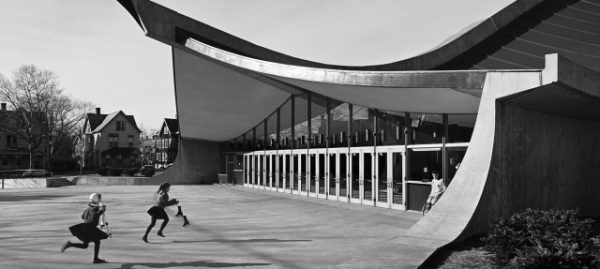Tehrani on Mies, Saarinen, and Discursive Opportunities

As an extension of our conversation last week, I would add a few thoughts in response to Tim’s blog below – this, as an opportunity to expand on the discussion, and to overcome some of its oppositions, which may lead to reductive readings.
The connection between past and future projects in any office are sometimes inevitable, but rarely are they necessarily interesting in themselves. For this reason, I would make a case for the so-called design agenda not so much as something that underlines ‘personal’ agendas, but rather the discursive opportunities they provide. In other words, the ability to link projects, arguments, and debates across history, culture and circumstances is something that may link a design project to a broader intellectual project. The intellectual project, for me, is not only a personal commitment, but one that advances a disciplinary commitment, and thus puts the personal agenda in a broader political and ethical sphere.
The Mies-Saarinen comparison is a good one, and it helps to advance both ideas: the intellectual project through iteration (Mies), as well as the alternative, the intellectual project through the speculation of varied materials, configurations, and morphologies. Though Tim’s characterization seems to align me with the former, I would actually suggest an alternative model where Mies and Saarinen are braided together to form a commitment that cuts across the binary composition of the argument. What is fascinating about Saarinen’s work, in fact, is the precise way in which he establishes part-to-whole relationships in his projects despite variations of vocabulary. In a similar way, the Mies of the Tugendhat House, Barcelona Pavilion, and IIT show an architect of vastly different linguistic potential, someone who cuts across material and formal languages with equal ease.
As clarification, while Saarinen’s approach did vary vastly from commission to commission, his approach should probably be differentiated from eclecticism: his individual works were highly studied material, formal and spatial artifacts that brought synthesis to each realm, even when they varied completely from his other works. In this sense, his strategic choice to speak in different languages across commissions should not be confused for lacking a disciplinary commitment, something that is here being cast as a personal agenda. In Saarinen’s work, what is fascinating is the red thread that crosses the boundary of vocabularies, from project to project, despite what may be visible at first glance.
Of course, it would be important to look at Mies and Saarinen in their own historical context to expand on this idea. Invariably the question of authorship looms behind both cases, with Mies’s later work falling into the trap of the very language he develops, while Saarinen is free to evolve from commission to commission. If Tim aligns Saarinen’s strategy with an acute awareness of his corporate clients’ varied identities, I would simply say that his brilliance came not so much in his dutiful acquiescence to those corporations, but rather his translation of their mandates into architectural terms that transcended their very culture, and with great linguistic range.
My challenge to the Utile-OU team was precisely this: how can they extend their own disciplinary research without apology on the one hand and at the same time develop a speculative spirit that takes bigger risks with form, organization, and materiality in response to their client audiences. These two agendas need not be pitted against each other if Architecture’s agency is to be considered as a central part of what we, as designers, bring to the equation. The middle ground to which Tim refers is not irrelevant, but is neither always here nor there. I am asking them for a both-and, and though their proposal is beautifully developed and conceptualized, I wonder if they are willing to take on the risk of failure, if only to advance the discourse of Architecture.
-Nader Tehrani